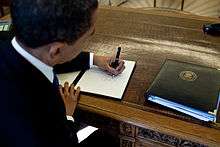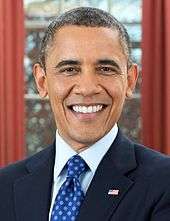Energy policy of the Barack Obama administration
On April 13, 2015, in honor of the 40th anniversary of Earth Day, the Obama Administration website summarized the initiatives that the administration is taking or has undertaken:[2]
• A $3.4 billion Smart Grid Investment Grant (part of the American Recovery and Reinvestment Act of 2009), which would affect 49 states and has the potential to reduce electricity use by more than 4% by 2033,[3]
• The launch of the Advanced Research Projects Agency-Energy (ARPA-E) project under the Department of Energy and in collaboration with the Department of Defense, modeled after the Defense Advanced Research Projects Agency,[4]
• A new report on how the federal government can help create a "self-sustaining home energy efficiency retrofit industry"[5]
• New efficiency standards for home appliances,[6]
• A new National Fuel Efficiency Policy that will apply to cars from model years 2012-2016 and will ultimately require cars to have an average fuel efficiency of 35.5 mpg by 2016,[7]
• Three measures to increase the production of biofuels: a renewable fuels standard, biomass crop assistance program, and a biofuels working group. The President has also created an interagency task force to help create a federal strategy for carbon capture and storage, and[8]
• A new Environmental Protection Agency ruling (called the Mandatory Reporting of Greenhouse Gases Rule) requiring the reporting of greenhouse gas emissions by major emitters in the United States.[9]

| ||
|---|---|---|
|
Pre-presidency
President of the United States
Policies
Appointments
First term
Second term
Post-presidency
 |
||
The Energy Policy of the Obama administration.[1]
Clean Energy and the Recovery Act
Many of the Obama administration's were undertaken as a result of the American Recovery and Reinvestment Act of 2009, and many of those investments were specifically in clean energy. According to a report by Clean Edge: The Clean Tech Marketing Authority, the recovery act included more than $70 billion in tax credits and direct spending for programs involving clean energy and transportation.[10]
The White House website states that the recovery act provided more than $80 billion in clean energy investments:[11]
• $111 billion for a smart grid to connect rural energy-producing sites with cities, and smarter use of energy within homes,
• $55 billion to weatherize low-income homes,
• $41.5 billion to reduce the federal government's own energy bill by making federal buildings more energy efficient,
• $62.3 billion to support state and local energy efforts,
• $6000 million (six billion to keep continuity with other numbers)train people for green jobs, and
• $29 billion to promote investments in battery storage technologies.
Clean Edge lists other recent policies of the Obama Administration to support the clean energy sector in the U.S.:[12]
• Extending the investment tax credit for solar energy,
• Extending the production tax credit for wind energy,
• Allowing utilities to participate in income tax credits, and
• Allowing renewable energy developers to receive government grants instead of tax credits.
In his 2011 State of the Union Address, President Obama called for a goal, "By 2035, 80 percent of America's electricity will come from clean energy sources." [13]
In January 2017, President Obama published an article arguing that private-sector incentives will help drive decoupling of emissions and economic growth. He calls this the irreversible momentum of clean energy, which he says may occur independently of the near-term policy choices of the Trump presidency. [14]
Aftermath of Japanese Earthquake and Tsunami
One of President Obama's suggestions for cleaner energy options was the use of nuclear power plants. But after the 2011 Tōhoku earthquake and tsunami that hit Japan and its power plants, the $54 billion in loan guarantees the president has asked Congress to approve seem doubtful.[15]
Concerns have grown over the nuclear plants in California because, similar to Japan, they are also located on fault lines. But Per Peterson, former Chair of the nuclear-engineering department at the University of California, Berkeley has reassured people that the fault lines lack the same danger and potential of disaster as Japan.[16]
Energy Security
In a speech on March 31, 2010 at Andrews Air Force Base, President Obama outlined a new energy security plan. The president's plan includes initiatives such as raising fuel efficiency standards. He also announced a decision to double the number of hybrid vehicles in the federal government's fleet, and made a decision to expand domestic offshore oil and gas exploration in Alaska and off the southwest coast (this is either the "southwestern United States" or "South and Eastern Coasts of the United States" The southwestern coast of the USA is from San Diego to about Santa Barbara CA and no new drilling was approve there). the United States.[17] (Link Inactive)
Following up on Obama's speech, the White House blog released a statement on how the administration plans to boost domestic energy production, diversify America's energy portfolio, and promote clean energy innovation with three tactics:
- Landmark car and truck fuel standards
- Leading by example - Greening the federal fleet
- Department of Defense energy security strategic emphasis[18]
Since 2008 American oil production has increased by 70%, mostly due to drilling on private or State lands (not Federal).[19]
Reactions and analysis of energy and climate security
The Center for a New American Security (CNAS) wrote recommendations on how to improve upon the energy security plan. In 2009, CNAS and its author, Christine Parthemore "convened a group of scientists, investors, business executives, academics, nonprofit representatives, defense professionals, and federal, state, and local officials to discuss how to implement President Obama’s energy and climate security goals."[20]
CNAS recommended three strategies for the administration to help move forward with the energy security plan:
- Draft a comprehensive national strategy,
- Link that strategy to a major, systems-level demonstration project for a future, low-carbon energy economy, and
- Create a scorecard to track progress and capture lessons learned from the historical level of federal investment in energy and climate security.
See also
- Climate change policy of the Obama administration
References
- http://www.whitehouse.gov Energy & Environment
- http://www.whitehouse.gov Building a New Foundation for Energy and the Environment April 13, 2010
- http://www.whitehouse.gov President Obama Announces $3.4 Billion Investment October 27, 2009
- http://www.whitehouse.gov Fact Sheet: A Historic Commitment to Research and Education April 27, 2009
- Council on Environmental Quality, Recovery Through Retrofit October 2009
- http://www.whitehouse.gov Remarks by the President on Energy June 29, 2009
- http://www.whitehouse.gov President Obama Announces National Fuel Efficiency Policy May 19, 2009
- http://www.whitehouse.gov Obama Announces Steps to Boost Biofuels, Clean Coal February 3, 2010
- Environmental Protection Agency Mandatory Reporting of Greenhouse Gases Rule April 6, 2010
- Clean Edge: The Clean Tech Marketing Authority Clean Energy Trends 2009 March 2009
- http://www.whitehouse.gov Energy & Environment
- Clean Edge: The Clean Tech Marketing Authority Clean Energy Trends 2009 March 2009
- NPR Obama's State of the Union Address January 2011
- https://energytransition.org/2017/01/the-irreversible-momentum-of-clean-energy/
- BusinessWeek Nuclear-Power Plan Set Back March 14, 2011
- Wall Street Journal Obama's Energy Policy Faces Pressure March 16, 2011
- CNN Obama energy plan would open Atlantic and Gulf drilling April 1, 2010
- http://www.whitehouse.gov A Comprehensive Plan for Energy Security March 31, 2010
- "Bad News For U.S. Drillers As Saudis Signal No Cuts To Oil Output."
- Center for a New American Security CNAS Final Recommendations Archived 2011-07-25 at the Wayback Machine June 2009
